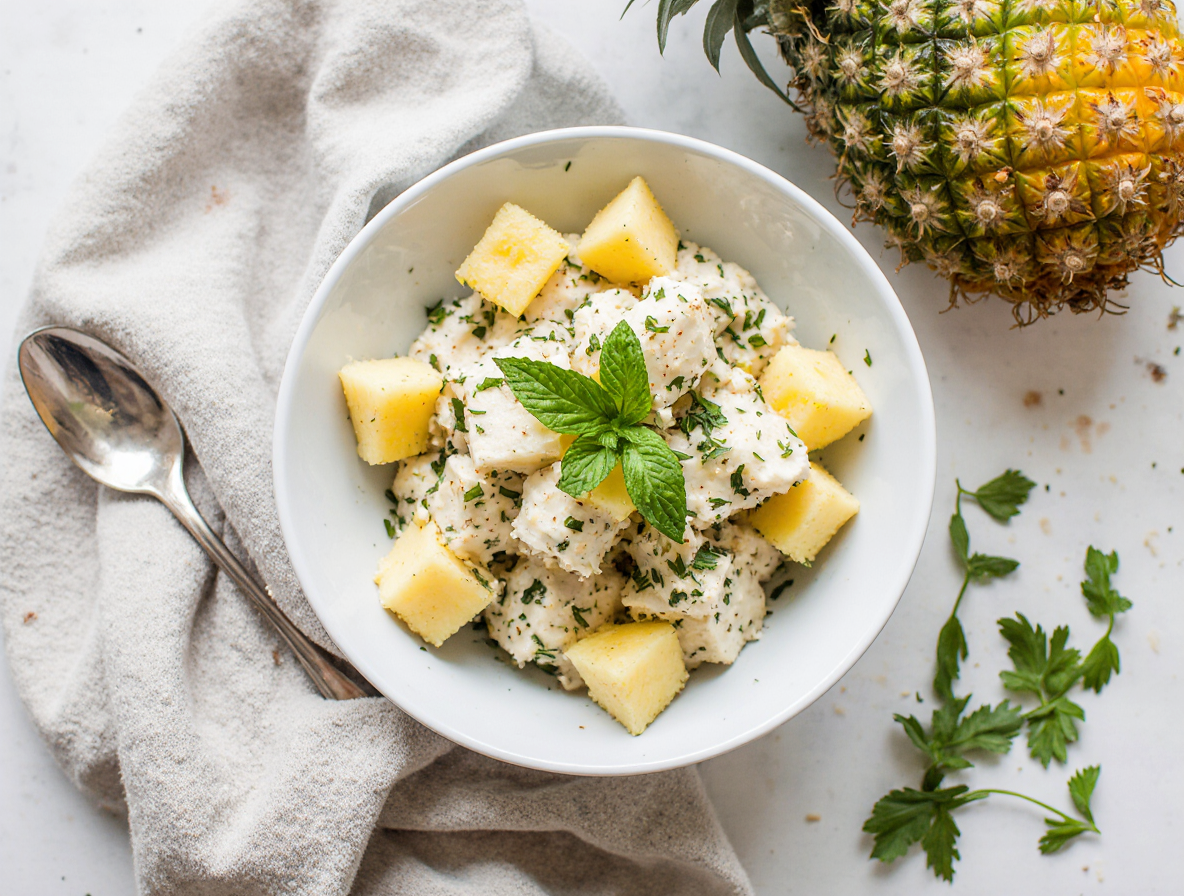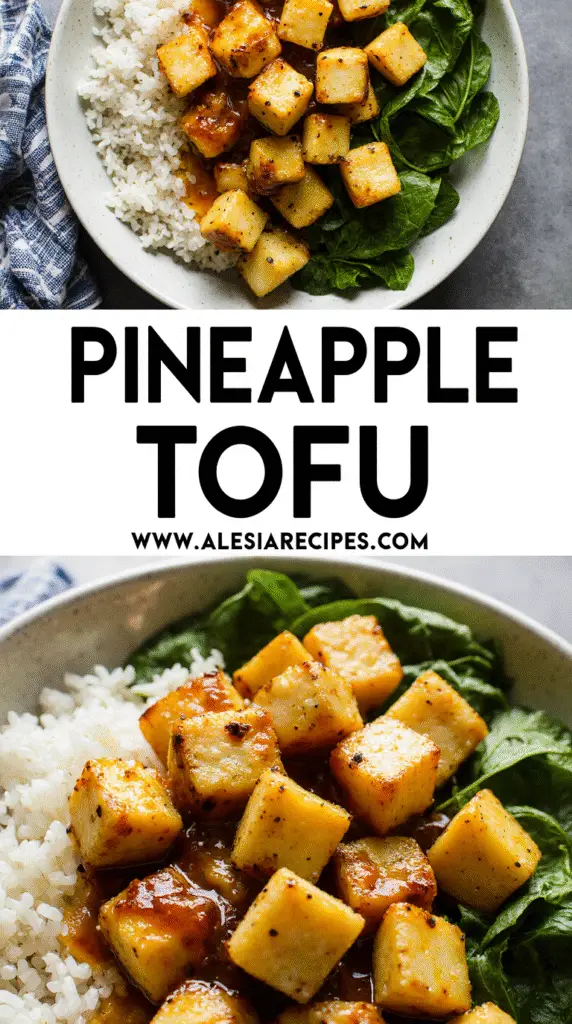How to Make Crispy Pineapple Tofu: A Foolproof Restaurant-Style Recipe
Craving pineapple tofu that’s better than takeout? This crispy, tangy dish comes together in under 30 minutes and requires just one pan.
I’ve tested countless tofu recipes, and I can confidently say this sweet and sour tofu with pineapple is not only way easier to make at home, but it’s also better than any version I’ve ever gotten delivered. The sticky pineapple tofu sauce consists of just a few simple ingredients, creating that perfect balance of fruity, tangy, and savory flavors. Whether you prefer a tofu pineapple stir fry or baked version, this pineapple tofu recipe works beautifully both ways.
While the crispy tofu won’t stay crunchy for long, I’ll show you exactly how to achieve that perfect restaurant-style texture and flavor in your own kitchen. From pressing techniques to sauce secrets, you’ll have everything you need to create a plant-based dish that will satisfy even the strongest takeaway cravings.
Gathering Ingredients and Tools
Before diving into the cooking process, let’s gather everything needed for our crispy pineapple tofu. The right ingredients and equipment make all the difference in achieving that perfect restaurant-quality dish.
Essential ingredients for pineapple tofu
The foundation of any great pineapple tofu recipe starts with extra-firm or firm tofu. This variety holds its shape better during cooking and absorbs flavors more effectively. Fresh pineapple provides the best flavor, though canned pineapple chunks work in a pinch.
For the sticky pineapple tofu sauce, you’ll need:
- Soy sauce (or tamari for gluten-free option)
- Rice vinegar (apple cider vinegar works as an alternative)
- Cornstarch for thickening
- Garlic and ginger for aromatic depth
- Sweetener like maple syrup or brown sugar
- Pineapple juice (from fresh or canned pineapple)
Optional add-ins and substitutions
Customizing your tofu pineapple stir fry is part of the fun! Consider adding bell peppers (red or green), red onions, or scallions for color and texture. Furthermore, edamame, corn, or chickpeas can boost protein content.
If tofu isn’t your preference, tempeh or plant-based chicken alternatives work wonderfully in this recipe. Additionally, those avoiding soy can experiment with seitan as the protein base.
For sauce variations, try adding:
- Sriracha or chili flakes for heat
- Kecap manis (sweet soy sauce) for deeper flavor
- Sambal oelek for spicy complexity
- Sesame oil for nutty undertones
Tools you’ll need for best results
First, a tofu press is invaluable for removing excess moisture. However, if you don’t have one, place tofu between paper towels with a heavy object on top as an alternative.
A good non-stick pan or wok is essential for achieving that perfect crispy exterior. A sharp chef’s knife makes preparing ingredients much easier, especially when cutting pineapple and tofu into uniform pieces.
Other helpful tools include:
- Mixing bowls for sauce preparation
- Wooden or silicone spatula for stirring without scratching cookware
- Measuring spoons and cups for precise sauce ratios
- Thermometer (optional) for monitoring oil temperature
With these ingredients and tools ready, you’re well-equipped to create a sweet and sour tofu with pineapple that rivals any restaurant version. The preparation may seem detailed, yet the results are absolutely worth it.
Prepping the Tofu for Crispiness
The secret to perfect pineapple tofu lies in the preparation. Getting that restaurant-quality crispiness requires a few crucial steps that many home cooks overlook.
How to press tofu properly
Pressing tofu is non-negotiable for achieving crispy results. This essential step removes excess moisture, creating space for the tofu to absorb flavors and develop that coveted golden crust. Initially, remove the tofu from its package and wrap it in paper towels or a clean kitchen towel.
For the DIY method, place the wrapped tofu on a plate, then position a cutting board on top. Add something heavy—a cast iron skillet or canned goods work perfectly. Press for at least 15-30 minutes. Pressing overnight yields even better results, just remember to change the paper towels occasionally.
If you use a tofu press, simply place your block inside and tighten according to manufacturer instructions. This typically takes 15-30 minutes as well, though some presses can stay in your refrigerator for several days.
Cutting tofu into ideal shapes
After pressing, the cutting technique significantly impacts your final dish. For pineapple tofu, uniform cubes between ¾-inch and 1-inch work best. This size allows for adequate crisping while maintaining a tender interior.
Place your pressed tofu on a cutting board and slice it evenly. Begin by cutting the block into thirds lengthwise, then slice those into columns, and finally into cubes. Consistency is key—uniform pieces ensure even cooking.
Coating tofu for extra crunch
Cornstarch is the secret weapon for achieving that restaurant-style crispiness. This simple coating creates a golden, crunchy exterior while sealing in moisture.
First, pat the cubed tofu dry. Subsequently, toss it with a small amount of oil and soy sauce for flavor. Sprinkle cornstarch over the tofu (about ½ cup per block), and gently toss until evenly coated with no powdery spots.
For extra flavor, mix seasonings directly into your cornstarch—garlic powder, salt, pepper, or even chili flakes create depth without additional effort. This simple step transforms ordinary tofu into crispy golden cubes ready for your sticky pineapple tofu sauce.
Remember, coating works best when the tofu is thoroughly pressed—waterlogged tofu will never achieve that perfect crisp exterior, regardless of your cooking method.
Making the Sticky Pineapple Tofu Sauce
The magic of pineapple tofu truly comes alive in the sauce. Creating that perfect sticky-sweet coating requires understanding a few key principles that transform simple ingredients into something extraordinary.
Sweet and sour flavor balance
Creating the perfect sticky pineapple tofu sauce is all about balance. Essentially, you need three key elements: sweetness, acidity, and umami depth. For sweetness, maple syrup or brown sugar works beautifully. The sour component comes from rice vinegar or apple cider vinegar. Soy sauce (or tamari for gluten-free options) provides that crucial umami foundation.
Some recipes incorporate:
- Tomato paste or ketchup for body and tanginess
- Garlic for aromatic depth
- Ginger powder for warmth
- Optional heat from sriracha or red pepper flakes
The ratio matters more than exact measurements—aim for equal parts sweet and sour, with umami as the supporting player.
Using fresh vs canned pineapple
While fresh pineapple offers superior flavor and nutritional benefits, it contains an enzyme called bromelain that can actually break down proteins. When using fresh pineapple in your sauce, be aware that this enzyme can quickly turn your crispy tofu mushy—sometimes in as little as 1-2 hours.
To prevent this, either:
- Cook your fresh pineapple juice or chunks first to neutralize the enzyme
- Or simply use canned pineapple, which has already been heat-treated
Both options work well, coupled with the fact that canned pineapple makes this recipe more accessible year-round.
Thickening the sauce with cornstarch
Cornstarch is the secret to achieving that restaurant-quality glossy thickness in your pineapple tofu sauce. First, combine all your liquid sauce ingredients in a pan and bring to a simmer. Meanwhile, create a cornstarch slurry by mixing 1 tablespoon cornstarch with 1-2 tablespoons cold water until smooth.
Once your sauce begins simmering, pour in the slurry while stirring constantly. Continue cooking for 1-3 minutes until the sauce becomes visibly thicker and develops a beautiful glossy sheen. For extra thick sauce, you can increase the cornstarch slightly—about ½ tablespoon extra if using maple syrup instead of sugar.
Cooking and Assembling the Dish
Now that your tofu is prepped and sauce is ready, let’s explore the various cooking methods to achieve that perfect crispy exterior.
Pan-frying vs baking vs air-frying tofu
Pan-frying delivers exceptional crispiness with minimal equipment. Heat about ¼ inch of oil in a non-stick skillet over medium-high heat. Once hot, add your cornstarch-coated tofu cubes in a single layer without crowding. Cook undisturbed for 5-6 minutes per side until golden brown. For extra crispiness, cover the pan with a lid to lock in heat.
Alternatively, baking offers a hands-off approach with less oil. Arrange tofu cubes on a parchment-lined baking sheet and bake at 400°F for 25-40 minutes, flipping halfway through.
For the quickest method, air-fry at 380-400°F for 15-18 minutes until golden brown. No flipping required, though you may need to cook in batches.
Combining tofu with sauce and pineapple
Once your tofu achieves that golden exterior, it’s time for assembly. For stir-fry versions, sauté vegetables like onions, bell peppers, and garlic in the same pan for 1-2 minutes. Add pineapple chunks and cashews if desired, allowing them to caramelize slightly.
Pour your prepared sauce over the vegetables, stirring immediately as it will bubble and thicken rapidly. Finally, gently fold in the crispy tofu, quickly coating each piece with the sticky sauce.
Serving ideas: rice, noodles, or lettuce wraps
Serve your pineapple tofu over steamed jasmine or coconut rice for a classic presentation. For a lighter option, try cauliflower rice or zucchini noodles.
Glass noodles provide an excellent base that can be enjoyed hot or cold. Furthermore, for an impressive presentation, serve the dish inside a hollowed-out pineapple half.
Crisp lettuce wraps offer a refreshing alternative – simply scoop the tofu mixture into lettuce leaf cups and top with green onions and toasted cashews.
Tips for keeping tofu crispy after saucing
The ultimate challenge with sweet and sour tofu is maintaining crispiness once sauce is added. Therefore, serve immediately after combining with sauce. If preparing components ahead, keep the sauce and tofu separate until serving.
When reheating, use an oven or air fryer at 350°F rather than microwave to restore crispiness. Lastly, for maximum texture contrast, consider pouring the sauce over individual portions rather than mixing everything together.
Conclusion
Mastering crispy pineapple tofu at home truly gives you a delicious alternative to takeout. After following these steps, you’ll have a perfect balance of sweet, tangy, and savory flavors that rivals any restaurant version. The careful preparation of tofu makes all the difference – pressing thoroughly removes excess moisture, while cornstarch creates that golden, crunchy exterior we all crave.
The sauce stands as the heart of this dish, therefore getting the right balance of sweetness, acidity, and umami flavors matters tremendously. Whether you choose fresh or canned pineapple depends on your preference, though each option offers unique benefits for your final dish.
Most importantly, the cooking method you select – pan-frying, baking, or air-frying – allows flexibility based on your kitchen setup and dietary preferences. Regardless of which method you choose, the result remains a deliciously crispy tofu that pairs wonderfully with the sticky pineapple sauce.
Finally, serving options provide endless possibilities. Rice, noodles, or even lettuce wraps transform this versatile dish to suit any occasion. Though keeping tofu crispy after adding sauce presents a challenge, the tips provided will help maintain that perfect texture until the last bite.
Next time your takeout cravings hit, I hope you’ll try this foolproof pineapple tofu recipe instead. The satisfaction of creating restaurant-quality food at home, alongside the wonderful aromas filling your kitchen, makes the entire process worthwhile. Your friends and family will certainly be impressed by your culinary skills!
FAQs
Q1. How can I achieve crispy tofu for my pineapple tofu dish? To achieve crispy tofu, press it thoroughly to remove excess moisture, cut it into uniform cubes, and coat it with cornstarch before cooking. Pan-frying, baking, or air-frying are all effective methods for creating a crispy exterior.
Q2. What’s the best way to make the pineapple sauce for tofu? The key to a great pineapple sauce is balancing sweetness, acidity, and umami. Use a combination of pineapple juice, soy sauce, rice vinegar, and a sweetener like maple syrup or brown sugar. Thicken the sauce with a cornstarch slurry for that perfect sticky consistency.
Q3. Can I use canned pineapple instead of fresh for this recipe? Yes, you can use canned pineapple. In fact, it’s often preferred as it’s already heat-treated, which prevents the enzyme bromelain from breaking down the tofu’s texture. If using fresh pineapple, cook it first to neutralize this enzyme.
Q4. How do I keep the tofu crispy after adding the sauce? To maintain crispiness, add the sauce just before serving. If preparing components ahead of time, keep the sauce and tofu separate until the last moment. When reheating, use an oven or air fryer instead of a microwave to restore crispiness.
Q5. What are some serving suggestions for pineapple tofu? Pineapple tofu pairs well with steamed jasmine or coconut rice for a classic presentation. For lighter options, try serving it over cauliflower rice, zucchini noodles, or in lettuce wraps. You can also get creative and serve it in a hollowed-out pineapple half for an impressive presentation.


